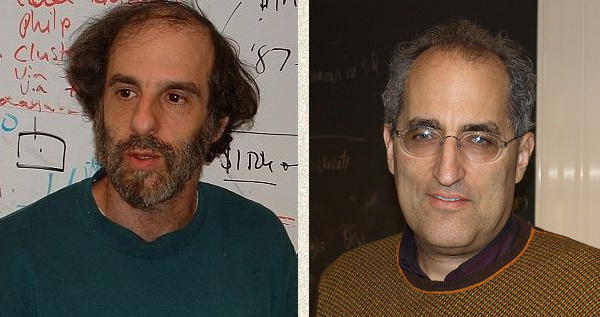The Genius Class of 2011
September 29, 2011
The
MacArthur Foundation has just announced its 2011 Fellows Class. Although the Foundation resists the appellation, these awards are commonly called the "Genius Grants." As in other years, there are a few
scientists on the award list, mixed in with the
poets and
musicians. This year, there's even a
condensed matter physicist, a
computer scientist, and an
organometallic chemist. I wrote about last year's Fellows Class in a
previous article (MacArthur Fellows 2010, October 5, 2010).
A benefit of the award, aside from the publicity, is an unrestricted monetary grant of half a million dollars. Painters could buy gold
paint that contains real
gold as a
pigment, and a musician could buy that
platinum flute he's lusted over since
college; but, what does a scientist do with that amount of money? She could take a one, or two year,
sabbatical to write that book that's been churning in the back of her head; not only that, but there would be enough money left over to buy copies for all her friends.

Two well known Macarthur Fellow physicists. Paul Ginsparg of Cornell University (left), and Edward Witten of the Institute for Advanced Study, Princeton, New Jersey (right). Ginsparg was a 2002 MacArthur Fellow. Witten was a 1982 MacArthur Fellow. (Via Wikimedia Commons, left image, right image).
Here are the six scientists in the 2011 class of MacArthur Foundation Fellows. The women scientists outnumber the men four-to-two.
Elodie Ghedin, Parasitologist/Virologist
Ghedin, age 44, is an assistant professor in the Department of Computational & Systems Biology at the University of Pittsburgh School of Medicine. She is also an associate investigator at the J. Craig Venter Institute. Her research uses genomic sequencing in the study of virulent human pathogens, especially parasites that cause such tropical diseases as leishmaniasis, sleeping sickness, Chagas disease, elephantiasis, and river blindness. By using genomic sequencing, Ghedin and her colleagues showed that influenza A in a New York City outbreak evolved genetically at a very high rate.
Markus Greiner, Condensed Matter Physicist
Greiner, age 38, is an associate professor in the Department of Physics at Harvard University. Greiner studies physical models of quantum systems that he prepares by assembling two-dimensional lattices of ultracold atoms. An apparatus that he designed can assemble thousands of these atoms which behave much like electrons in a solid-state crystal. He also built a quantum microscope that allows direct visualization of individual atoms in these lattices. His model system simulates superconducting and magnetic systems and their phase transformations.
Sarah Otto, Evolutionary Geneticist
Otto, age 43, is a professor in the Department of Zoology at the University of British Columbia (Vancouver, BC). Otto does research on fundamental questions of population genetics and evolution. One topic area is diploidy, in which organisms have two copies of some genes. Diploidy is a means to mask the effects of deleterious gene mutations, since a second, non-mutated gene will still function. Having more genes, however, increases the likelihood of mutation. Otto and her colleagues found that an evolutionary balancing act takes place in which sexually reproducing species can better tolerate multiple gene copies, but asexual species tend to stick to single gene copies. Otto is a co-author of the 2007 book, "A Biologist's Guide to Mathematical Modeling in Ecology and Evolution."
Shwetak Patel, Sensor Technologist & Computer Scientist
Patel, age 29, is an assistant professor in the Department of Computer Science & Engineering at the University of Washington (Seattle, Washington). Patel's research is on low-cost and easy-to-deploy sensors that can be used as energy monitors in homes. Patel found that individual appliances can be identified by the electrical noise that they inject into the house wiring. His sensor networks are designed to perform a continual energy audit to promote energy efficiency and conservation.
Melanie Sanford, Organometallic Chemist
Sanford, age 36, is the Arthur F. Thurnau Professor of Chemistry at the University of Michigan (Ann Arbor, Michigan). Sanford uses metals, particularly palladium, to catalyze reactions that break carbon-hydrogen bonds to insert functional groups into complex organic molecules. Her techniques simplify reactions, and are often a route to production of a specific enantiomer of a molecule. Such selectivity is important in pharmaceutical development.
Yukiko Yamashita, Developmental Biologist
Yamashita, age 39, is a research assistant professor in the Life Sciences Institute of the University of Michigan (Ann Arbor, Michigan). Yamashita's research is on the mechanisms that regulate stem cell division. Her focus is on stem cell senescence, and she further investigates the mechanisms responsible for runaway stem cell division, which is the primary cause of some cancers.
It's interesting that two of the Fellows (Sanford and Yamashita) are from the same university. I don't know how the Fellows are selected, but the University of Michigan may have an advocate. The average age of these six MacArthur Fellows is thrity-eight, so I'm way past my
expiration date.
Reference:
- MacArthur Fellows Program, Meet the 2011 Fellows, MacArthur Foundation Web Site.
Permanent Link to this article
Linked Keywords: John D. and Catherine T. MacArthur Foundation; scientist; poet; musician; condensed matter; physicist; computer scientist; organometallic chemist; paint; gold; pigment; Density 21.5; platinum flute; college; sabbatical; Paul Ginsparg; Cornell University; Edward Witten; Institute for Advanced Study; Princeton, New Jersey; Elodie Ghedin; Parasitologist; Virologist; University of Pittsburgh School of Medicine; J. Craig Venter Institute; genomic sequencing; pathogen; parasite; leishmaniasis; sleeping sickness; Chagas disease; elephantiasis; river blindness; influenza A; New York City; Markus Greiner; Department of Physics; Harvard University; physical model; quantum system; lattice; ultracold atoms; electron; solid-state; crystal; microscope; superconducting; magnetic; phase transformation; Sarah Otto; Zoology; University of British Columbia (Vancouver, BC); population genetics; evolution; diploidy; gene; mutation; sexual reproduction; species; A Biologist's Guide to Mathematical Modeling in Ecology and Evolution; Shwetak Patel; sensor; University of Washington (Seattle, Washington); energy; electrical noise; Melanie Sanford; University of Michigan (Ann Arbor, Michigan); metal; palladium; catalysis; catalyze reactions; carbon; hydrogen; bond; functional group; organic molecule; enantiomer; pharmaceutical; Yukiko Yamashita; Developmental Biologist; stem cell; division; senescence; cancer; expiration date.